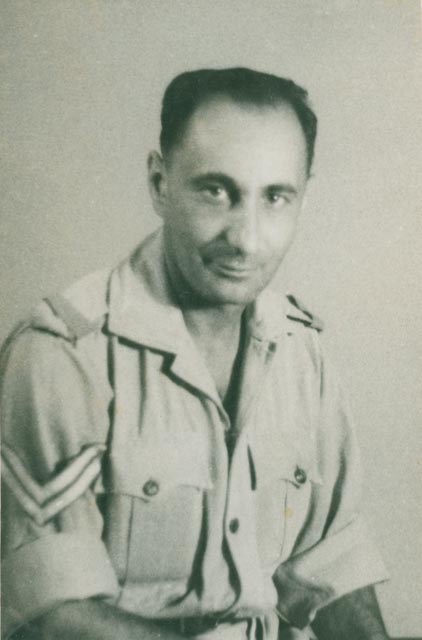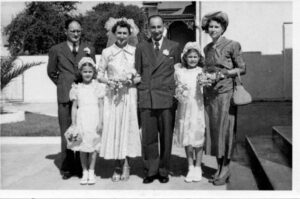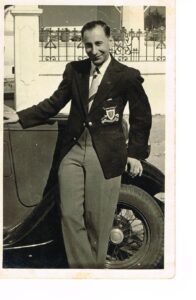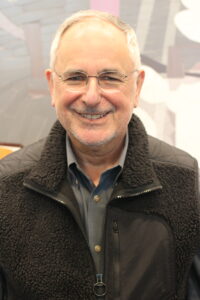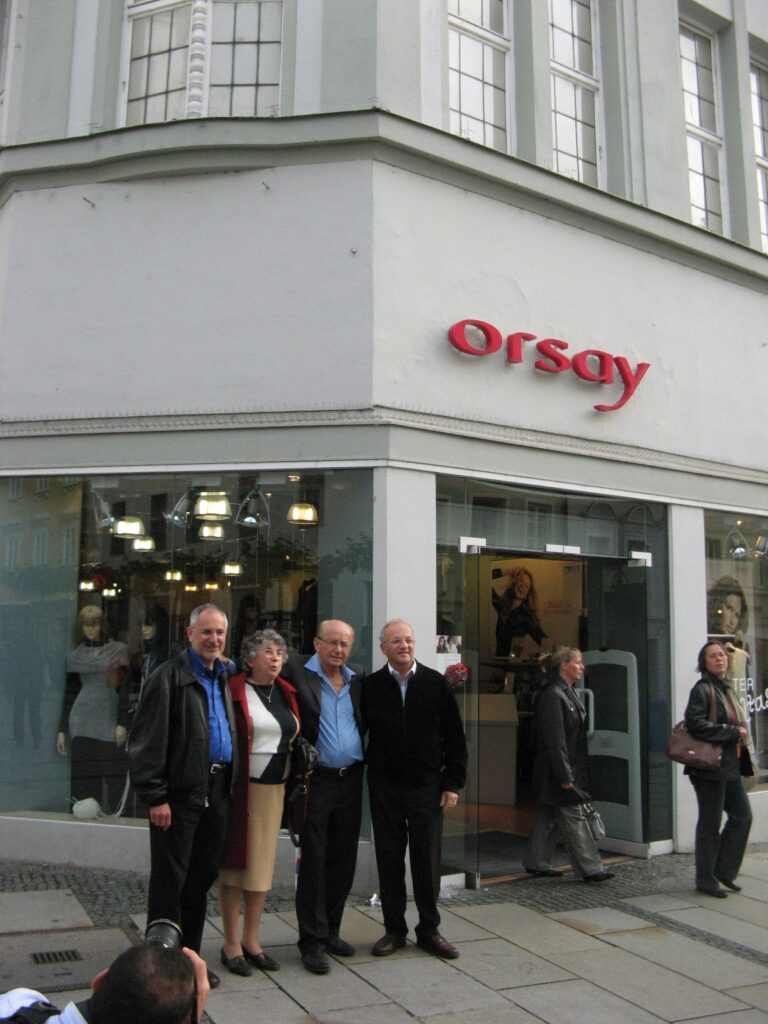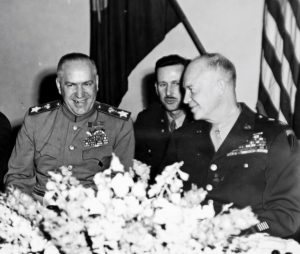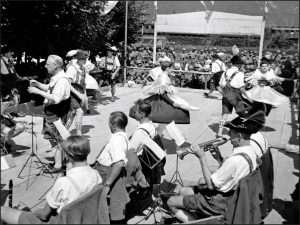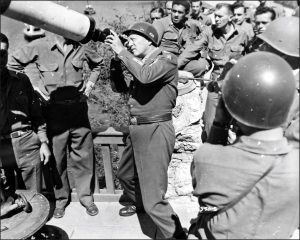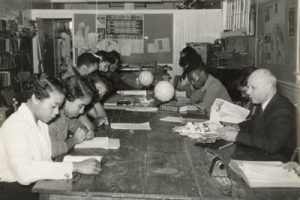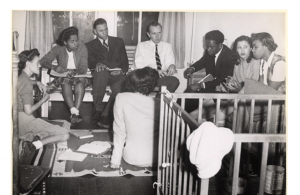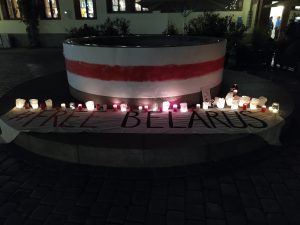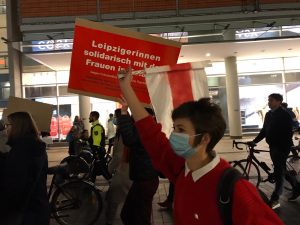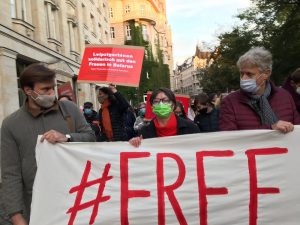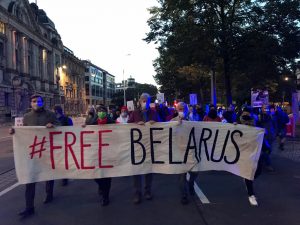by Anna Rosmus
Anna Rosmus uses archival material and interviews to follow the paths of former Passau residents. Quotes not cited are from her conversations and correspondence.
This piece is the first of two on the Bernheim family of Passau. After fleeing Passau they headed to Cape Town and San Franscisco. Those stages of their story will be posted next month.
While Napoleon spread the concepts of liberty, fraternity, and equality into Central Europe, it was not until April 22, 1871, when the Constitution of the German Reich was extended to Bavaria, that Jews in all of Germany reached their emancipation.[1] At that time, more than half of them lived in Prussia, and one fifth in Bavaria.”[2]
Among the 4,000 Jews who lived in Königsberg,[3] were Jakob[4] and Therese[5] Loose. They had five children.[6] Their eldest son, Max,[7] married Julie Kronenberger,[8] daughter of a textile merchant for whom he worked in the Rhineland.[9] Their third son, Albert,[10] left school at the age of 14 to become rich. In 1893, he became manager of the Max Knopf Ravensburg branch, and before long, Warenhaus Geschwister Knopf hired Albert Loose to manage its Karlsruhe store.
When Gabriel A.[11] and Mathilde[12] Bernheim from Buchau,[13] a small town in the Biberach district, near Lake Federsee, relocated to Ravensburg, their son Alfred[14] finished a merchant’s apprenticeship before he worked as a traveling salesman for various companies in Southern Germany. Their daughter Martha[15] became an apprentice in Bruchsal,[16] approximately 13 miles northeast of Karlsruhe, and their daughter Rosa[17] was trained as a fashion stylist.[18] Albert Loose met Rosa in a Ravensburg cafe. On February 7, 1898 the couple married, and settled in Karlsruhe. When their son, Walter, was born,[19] Gabriel and Mathilde Bernheim closed their Ravensburg store, and moved back to Buchau to take care of their grandson.
Heading for Passau
At the turn of the 19th century, commerce in the tristate area around Passau[20] picked up. For textile merchants from major Jewish centers, this city near the Austrian and Czech border was a potentially lucrative start-up location. While it had a long history of anti-Semitism,[21] it could attract a wide range of customers.[22]
In 1892, Adolf Hitler’s father transferred from Braunau, Upper Austria, to the larger customs office in Passau.[23] Five years later, when Prince Ludwig[24] visited merchant Salomon Forchheimer,[25] even the Donau-Zeitung,[26] a staunchly Catholic regional newspaper, reported extensively and with deference.
Shortly thereafter, all three Bernheim siblings and their spouses seized the opportunity to branch out there as well. Alfred was the first. In 1897, he and Julius Pick,[27] traveling salesmen from Weiden, Upper Palatinate, opened Pick und Bernheim, a Passau textile store at Neumarkt 291.[28] The business went well. On November 10th, Bernheim’s younger sister, Martha, joined the staff as a sales woman.[29]
In December 1900, Alfred Bernheim sent his brother-in-law, Albert Loose in Karlsruhe, a letter that Julius Tietz[30] was closing his Passau store. It was located on Neumarkt 315,[31] at the main shopping street, and owned by Anna Pöllmann.[32] Sensing an opportunity to open his own shop, the next Saturday, after closing time, Loose took a train to Passau, where he talked with Bernheim, Tietz and the landlady.
On March 1, 1901, Albert and Rosa Loose, née Bernheim, moved to Passau with their son, Walter. The family shared their 3-room apartment above the store with Martha.[33] It was cramped, because they also needed one of these rooms for business purposes.
Albert Loose recalled:
The Donau-Zeitung, the organ of vicar Pichler,[34] had a large circulation. As this vicar was one of the few Zentrum[35] delegates who agitated with anti-Semitism, so [was] his newspaper, but at least the advertisements it liked to accept. The anti-Semitism of the front page reinforced the effect of the advertisement. Among the public one could not notice any anti-Semitism, only among the competition which was largely protestant. There also existed a protestant newspaper, the Passauer Zeitung.[36] This one had a small circulation, was eager to obtain advertisements which were of little value, however.
For March 9, 1901 Loose placed one advertisement in the Passauer Zeitung, and for March 12, 1901 another in the Donau-Zeitung. On March 16th, ads on four pages of the Donau-Zeitung announced, “Albert Loose, store-opening, Sunday, March 17th, 10:15 AM.” The first customer who purchased for five Marks on that day was promised “a real golden watch free.”
“After the usual difficulties,” Albert recalled, “advertisement caused the desired sensation.” A smarty came in, grabbed the first thing she saw, and claimed the watch. Loose recalled so many people inside and outside of the shop, however, that repeatedly he had to close the front door. Some people had to leave through a side door before others could enter. Promptly, a competitor sued, alleging Loose’s bidding for an unpermitted lottery. The court refuted that, deeming the award to have been shrewdly won instead.
1902: Founding Merkur Ltd.
After one year, the Loose store was already getting cramped, and the couple was eying Neumarkt No. 384, a large property across the street. Anna Pöllmann, their current landlady, owned it, too. When she planned to close down her own store with manufactured goods,[37] Loose seized the opportunity to upgrade. He recalled:
She had such trust in my business accomplishments that she offered me this house without any down payment. I could move into the larger house, and the smaller premises she could rent out to a book store.
The new premises I had to restructure. First floor and second floor for the business.
On August 25, 1902 Alfred Bernheim returned to Passau.[38] To better position themselves on the regional market, Bernheim and Loose created Kaufhaus Merkur LtD.[39] In combining both stores, the brothers-in-law became business partners. Loose explained in his memoirs:
In order to not depend on a bank, I reached an agreement with my brother-in-law, that he made his funds available to me, and both of us would split our business profits.
The opening of these premises occurred on September 28, (also a Sunday), after church. The public crowd before the opening was documented in a picture. This photo and the opening advertisements my son still has in his possession.
Promptly, Albert Loose landed in court, again. He recalled:
Into the “law against unfair competition” regulations about [a] sale were newly added. I also asked the Munich lawyer, with whom we negotiated the business transformation, whether according to the regulations, I was allowed to hold a sale due to business change. The lawyer did not have the least concerns. And yet, I was served an indictment, and had to appear before the jury in Straubing.
Loose wrote about being fined merely symbolic three Marks.
On October 1, 1902 Julius and Henriette Pick, née Lederer, purchased an imposing building[40] on the same block. On the first and second floor, they opened their own department store. Loose recalled that the Jewish couple added “many of our products to their manufactured goods store.”
In the meantime, Heinrich Himmler and his family moved to Passau as well.[41] His father, the Roman Catholic Gymnasialprofessor Gebhard Himmler, was promoted to deputy principal of Königlich humanistisches Gymnasium, the humanistic secondary school.
Branching out in Deggendorf
Deggendorf, nicknamed Gate to the Bavarian Forest, is situated where the Isar River meets the Danube. Like Passau, the town had a long history of anti-Semitism,[42] but also the potential to attract a wide range of customers.[43]
Loose reminisced:
My brother-in-law, Alfred, could not get along with Mrs. Hansi Pick, the wife of his associate, … and came to agree with Pick on a separation, by taking over premises in Deggendorf that the Pick and Bernheim company had rented.
I furbished the store and ordered the merchandise.
On August 1, 1901 Alfred Bernheim left for Deggendorf. On August 13th, Firma Alfred Bernheim registered a department store.[44] The four story-building was located in House No. 175, on Luitpold Plaza 4, and one of the largest business buildings in town.[45] The store received telephone number 51, one of the first local connections. Bernheim hired ten female employees, and within a few weeks another four.[46] Among them was his younger sister, Martha.[47]
When the Kaufhaus für Manufaktur-, Kurz- & Weißwaren, Kolonialwaren (department store for manufactured-, sewing- & white wares, colonial goods) opened in September, it was the first Jewish business in the district.[48] Multiple, large advertisements in the Deggendorfer Donaubote announced the new endeavor.
In October 1902, Max Stern,[49] a trained window decorator for retail stores, became its manager. Alfred Bernheim began to commute between Passau and Deggendorf, and Loose recalled purchasing new items in Berlin, Vienna and Paris. To obtain bulk rates in Leipzig and Nürnberg, he ordered together with former colleagues in Karlsruhe.
On January 11, 1903, in Regensburg, Alfred Bernheim married Bertha Lederer,[50] a younger sister of Julius Pick’s wife, Henriette. On June 25, 1903 Alfred Bernheim returned to Deggendorf, where the couple moved to House No. 77,[51] and had three children. Helene, privately called Lene, was born on November 16, 1903, Siegbert Joseph on February 20, 1905, and Felix on March 23, 1906.
Busy Time for Jewish Entrepreneurs
The total Passau population was approximately 18,000. In 1904, the Regensburg district rabbi supervised 34 Jews in Passau.[52] At that time, most Jewish residents were either recorded as “Israelites” or without religion. All were assimilated. Looking at Passau newspapers, it is obvious that neither their daily life nor special activities were of much interest to the vast majority. Hardly anything is ever reported.
During August 1903, Martha Bernheim worked for Loose. On June 26, 1905, he registered the Passau Merkur as a textile business, and he advertised it as “biggest warehouse of Passau”, with a “large selection, cheapest but firm prices.”[53]
After the death of Gabriel Bernheim on April 26, 1906, his widow, Mathilde, was severely depressed. In the summer, she joined her daughter, Rosa Loose, for three months in Passau.[54] At that time, plans for a Passau synagogue failed to materialize,[55] and Anjes Brooijmans noted on May 15, 2013, that “Albert Loose liked Passau very much, but he didn’t like the people!” In September 1906, Loose informed the city registrar about his return to Königsberg.
Beginning on September 18, Alfred Bernheim managed the Passau Merkur. His sister Martha helped with the transition.[56] Merkur now had telephone number 45, one of the first connections in the city.
Extended Mishpocha
On January 10, 1907 Martha Bernheim and Max Stern married in Deggendorf.[57] The couple had two daughters.[58] On January 1, 1908 Max Stern acquired the Deggendorf Merkur[59] from Alfred Bernheim, his new brother-in-law. With that money, Bernheim updated the Passau Merkur.[60]
When Albert Kürzl in Deggendorf sold his building to fellow merchant Karl Vanoni on February 15, 1909, however, the Sterns had to relocate. On April 24, 1909 they purchased House No. 173[61] from Xaver Friedl. Before moving there in 1910, Stern began to remodel.[62] For the store opening in April 1910, he was looking for “4 capable 1st sales women who already were active in vivacious, better stores.”
In 1910, 73 Jews lived in Passau. In December, Alfred and Bertha Bernheim purchased Loose’s share of the Passau Merkur,[63] and the couple continued to expand its estate in a prime business location.[64]
The Sterns in Deggendorf expanded as well. In order to add toys to its assortment during November and December, Merkur requested annual permits from 1908 until 1911. According to the Deggendorf Adressbuch 1911, Stern also sold umbrellas and canes.
Among their employees were Regina Stern[65] and Luise Bernheim.[66] According to the city archives, in 1913 Max Stern maintained a staff of 25 to 30 people. On July 23, 1913 he became a citizen. After attending the local elementary school, his daughter Else was among the first girls to be accepted at the local Ludwigs-Realschule.
On October 16, 1919 Herta Souhami[67] joined Stern’s staff. She was the granddaughter of Ida Moos,[68] a sister of Mathilde Bernheim, and thus a cousin of Martha Stern.
The Stab-in-the-Back Myth
After World War I, the notion was spread that German Jews, in solidarity with the enemy, had caused Germans to lose the war, and that their peace activities resulted in unjustified reparations. Kurt Eisner,[69] Bavaria’s first Minister President, happened to be Jewish. In February 1919, he was assassinated. His murderer had graduated from Königlich humanistisches Gymnasium[70] in Passau.
In April 1919, Franz Schrönghamer-Heimdal proclaimed, ”Bavaria for the Bavarians! … We now want to be a free people on free soil and not slaves of the Jew. … We must get rid of the Jews ourselves.”[71]
In a letter from December 2, 1919 to Feldmarschall (Field Marshal) August von Mackensen,[72] Wilhelm II deemed his abdication the deepest, most disgusting shame ever perpetrated by a person in history, the Germans have done to themselves”, “egged on and misled by the tribe of Judah. … Let no German ever forget this, nor rest until these parasites have been destroyed and exterminated from German soil![73]
Trouble at the Height of Their Career
Undeterred, Felix, Siegbert and Helene Bernheim attended a liberal secondary school and excelled in sports. All three were at the center of the city’s social life. In their leisure time, both sons donned ethnic outfits.
In 1922, the Sterns in Deggendorf added novelty items such as bed feathers to their assortment.
Lower Bavaria was a problematic spot, however. Passau teacher Richard Kufner had already set up local storm troopers (SA), a primitive and extremely violent group.[74] After Hitler spoke in the Schmerold Celler on August 7, 1922, locals formed their own SS group. Known as “the mobile Passau squad,” it violently suppressed political opponents in Lower Bavaria, Upper Palatinate, Upper Bavaria, and Upper Austria.
On June 17, 1923, a few hundred guests, including delegations from Stettin, marched behind Hitler, Himmler, Göring and a Swastika banner into the Passau cathedral, where it was blessed.[75] On February 14, 1925, the future Reichsführer SS Heinrich Himmler revisited Passau, and shortly thereafter, the first formal boycott of Jewish businesses took place.
Doggedly, both Bernheim sons continued their business training,[76] and in 1926, a plan for the construction of a new Merkur department store was drawn up. One year later, the installation of two apartments on the third floor with a total of 10 rooms was approved. At that time, the Bernheims owned a spectacularly modern department store with approximately 100 employees. It was the largest and most popular business of its kind in the tristate region.[77]
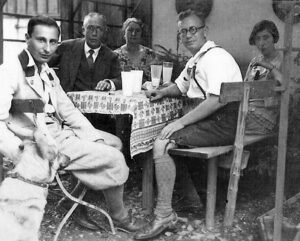
Left to right: Felix, Alfred, Bertha, Siegbert and Helene Bernheim
Internally, the relationship between the elder Picks and Bernheims had reached an all-time low. The five children of both families, however, had always been friends, and as grown-ups, they opted to become business partners as well. Before Alfred and Bertha Bernheim celebrated their silver wedding anniversary, in January 1928, they passed on Merkur to their sons, and Henriette Pick passed her store to daughter Paula.[78] After these heirs combined their stores into one company, Felix, an extraordinarily innovative man, and his brother advanced the family business into one of Lower Bavaria’s most modern endeavors. Albert Loose described his nephew Siegbert as prudent, managing with deliberation, whereas he called Felix a “Draufgänger” (risk-taker). He also was one of the city’s most eligible bachelors.
When Trudl Burian, a college-bound Passau socialite,[79] won 1st place for best carnival costume,[80] the Stürmer magazine launched another, lengthy wave of attacks against Jewish-owned businesses.[81] For the Passau region, this was the beginning of their end.
On July 15, 1929, Helene Bernheim married Lutz Wertheimer[82] and followed the merchant to Saarbrücken,[83] where the couple opened a tie business. Her brother Siegbert headed for Osterode[84] near Königsberg.[85]
Bailing out Merkur LtD
As soon as the Niederbayerische Rundschau, a regional weekly National Socialist newspaper, was founded,[86] its editor-in-chief, Otto Erbersdobler,[87] demanded, “Don’t buy from Jews!” On January 9, 1931, the Niederbayerische Rundschau wrote about its fictional reporter “Florini” visiting a fortune teller. Answering the question what will happen to the Jews in the Third Reich, she prophesied:
I see a freight car standing at the platform of the heart of your city, there stands an infants’ home instead of a department store. A fat Socialist city counselor is nabbed while escaping from the crematorium; he is stuffed and added to the collection of rarities in the Oberhaus [Castle]. … In the city on the Ilz a new ghetto is being established for the so-called decent Jews.
On June 5, 1931 Else Stern married Herbert Kirstein[88] in Deggendorf. The couple had one daughter.[89]
After the Donauzeitung reported about the so-called Deggendorfer Gnad[90] in October 1931, Felix Bernheim complained publicly that such “mendacious tales should not be told” to people of the 20th century.[91]
Felix Bernheim at the Passau “MERKUR” office
When the bank cancelled their credit, however, the Bernheim sons and Paula Pick grew desperate. To stay afloat, they contacted Paula Reichenberg and Albert Loose.[92] Recalling a market of merely “18,000 residents whose Austrian customers went lost due to the peace treaties at that”, Loose balked. Paula Reichenberg lent her sister Henriette 20,000 Marks to purchase the large property that “separated” her daughter’s department store from the Bernheims,[93] and all agreed that Alfred and Berta Bernheim will buy back their businesses in Passau and Osterode. To do so, the Bernheims needed money. In the end, Loose did lend his brother-in-law 20,000 Marks as well – with the life insurance that Alfred and Berta had in Switzerland as security.[94]
Shattered Dreams
In 1932, Albert Loose’s older brother, Max, was President of the Jewish Community in Lower Bavaria.[95] It was an uphill battle. From November 1, 1932, until January 28, 1933, a new daily, the Passauer Wacht,[96] was published. In December, the Passauer Zeitung wrote:
In the department stores, all is a glitter and a twinkle. Giant zeppelins float back and forth in the display windows, the most incredible children’s toys – ones that normal people cannot afford – make the children dissatisfied with their own meager Christmas table, unaffordable outfits, in short, there is scarcely anything that is not offered for sale. In contrast, the display window of the small businessman is frequently empty, often without even the crudest lighting. Thousands of small businessmen are compelled to torment themselves with the terrifying thought, “will the noose finally be tightened tomorrow, or will the department store Jew allow us to twitch a while longer?” Everyone has to believe this will happen sooner or later in one way or another. … But the department stores will continue to expand and flourish. How long still? Until that day?
The Passauer Woche added, ”There is no doubt about this, always when a Jew does business, the Christian generally ends up empty-handed.”
The vast majority of Passau residents remained mute,[97] and with all assets invested in real estate and merchandise, most merchants tried hard to hold on. In Passau, Felix Bernheim managed the department store and the family’s significant estate.
When Hitler seized power in 1933, Germany had approximately 523,000 Jews, less than 1% of the population.[98] In Passau, only 40 were still registered.[99]
On March 14th, Passau named Adolf Hitler a citizen of honor.[100] The Innstadt house where he used to live, was “cleansed” of Jews.[101] A Führer cult became more and more visible,[102] and Passau’s right-wing reputation[103] attracted more NS-leaders.[104]
Felix Bernheim continued to be popular, however. After he was arrested on March 31, 1933, and placed in “protective custody” for “grinning” at Max Moosbauer, the newly appointed National Socialist mayor, his “Aryan” staff signed a daring petition, successfully requesting his release.[105] Like thousands of other victims of political, racial or religious persecution, Felix fled to the Territory of the Saar Basin.
The new Passau administration began to restrict Jews. On April 13, 1933, the official bulletin of the city council announced that Jewish entrepreneurs and tradesmen would no longer be permitted to take part in either one of the two traditional fairs or any other exhibitions in order not to endanger public peace and order. One week later, the politically appointed Special Commissary forbade “the playing of Jewish popular songs and Jazz music in any restaurant or cafe within the city limits of Passau.” On May 5, 1933, the Passauer Zeitung reported, ”It might further interest the public that in the future, non-Aryan companies are to be excluded from contracts to make deliveries to municipal welfare agencies.” And on June 2, 1933, the notorious Otto Erbersdobler became president of the Chamber of Commerce and Industry.
On August 7th, Gerda Stern left Deggendorf for Brighton, England.[106] In July, 1934, Max Stern handed the Deggendorf Merkur over to his son-in-law, and left for Munich.[107]
In the meantime, Passau leaders already dreamed of a Reichsautobahn from Passau to Königsberg,[108] cutting through the Polish Corridor. To celebrate the Battle of Tannenberg from 1914, Generalfeldmarschall August von Mackensen visited Passau,[109] and two years after its triumphant Passau rally from 1933, the Verein für das Deutschtum im Ausland flocked to Königsberg.
In the Passau city council minutes from August 13, 1935, we read:
a, The civil servants and employees are to be made aware that they are not to make purchases from Jews, otherwise they will have to bear the consequences. The civil servants and employees are to prevail upon members of their families to this effect. Whoever receives his salary or wage from the state or municipality may not stab the state in the back, rather they must support the state. b, Welfare recipients are likewise to be made aware that they are not to buy from Jews. Signs to this effect are therefore to be posted in the welfare offices. Violations will result in loss of support. c, Business people and entrepreneurs who make purchases from Jews cannot expect orders from the state. d, The administrative offices of institutions and foundations are instructed once again not to make purchases from Jews. If there is uncertainty whether a firm is a Jewish company or not, then an inquiry is to be made at the district administration of the NSDAP. e, The inmates of institutions and foundations are likewise to be instructed not to buy from Jews.
On August 31, 1935 the new city hall was dedicated with a huge demonstration “Against Jewry and political Catholicism.”
By October 31, 1935, Passau National Socialists were happy to announce that the Merkur department store was finally in “Aryan” hands,[110] and on November 22, 1935, the city was proudly declared to be free of Jews – even if it was not yet so.[111]
In September 1936, after selling the Deggendorf Merkur to Franz Falter, a non-Jew, Herbert Kirstein and his family left for Essen, where his mother lived.[112]
During the night of November 9/10, 1938 the interior of the Straubing synagogue was destroyed. Jewish men and some women were arrested. On November 11, the Passau newspaper reported, “Yesterday night, spontaneous demonstrations were in Passau, and to some extent in the surrounding area against those Jews still present; in the course of which the Jews were taken into protective custody.”[113]
Life for the remaining Jews was miserable.[114]
Notes
[1] For the first time, Jews were entitled to serve in the military, in schools and in the legal system.
[2] Rürup, Miriam: Demographics and Social Structure (translated by Insa Kummer), in: Key Documents of German-Jewish History, 22.09.2016. <https://dx.doi.org/10.23691/jgo:article-224.en.v1>
[3] That equaled 3.5% of the city’s residents. With many migrants escaping pogroms in the Russian empire, the number of Jewish Königsberg inhabitants temporarily peaked at about 5,000 in 1880. After Berlin and Breslau, this was Germany’s largest Jewish community.
[4] Produkten Händler Jakob Loose was born 1839 in Polzin, East Pomerania. In 1905, the 5,046 predominantly Protestant inhabitants of Polzin included 110 Jews and 36 Catholics. After WWII, Polzin became Połczyn-Zdrój, Poland.
[5] Therese Meyer was born in 1845 in Stettin, East Pomerania. Because there were so many Meyer Jacobys in this city, her father or grandfather had changed his name from Meyer Jacoby to Jacob Meyer. After WWII, Stettin was renamed Szczecin, and a part of Poland.
[6] Siegfried was born in 1871, and died in 1872. Paul was born in 1882, and died in 1888, after falling into a cow skin cleaning tub with very hot water.
[7] Max Loose was born in 1870.
[8] Julie Kronenberger was born on March 13, 1873 in Saarlautern (Saarlouis). She was a resident of Stuttgart.
[9] The couple had two children, Franz and Fanny. Both were born in Stuttgart. Dr. Franz Loose became an eye specialist, married Lisl Midas, and had one daughter, Eva. Fanny Loose married Walter Frank, and had also one daughter, Greta, who was born in Straubing on January 12, 1925.
[10] Albert Loose was born on June 16, 1873. In 1940, at the age of 67, he began to write his memoirs “for my grandchildren and their descendants, perhaps they are interested in it.” Because Loose lost all papers in 1936, in Barcelona, Spain, he cautioned about possible inaccuracies. Unless noted otherwise, all personal information about Albert Loose and his immediate relatives is taken from those memoirs, as shared by Anjes Brooijmans, widow of his youngest grandson. Born on July 18, 1933, Anjes joined the Loose family in 1962.
[11] Gabriel A. Bernheim was born on September 12, 1840 in Buchau, and died there on April 26, 1906. He was one of Veronika and Abraham Simon Bernheim’s ten children.
[12] Born on June 24, 1849 Mathilde Moos was one of eleven children of Hermann Moos (May 7, 1816 – March 12, 1889) and Sofie Neuburger (September 17, 1819 – March 2, 1904) in Kappel near Buchau. Hermann Einstein, father of the physicist Albert Einstein, was Mathilde’s first cousin.
[13] Jews in this region were first mentioned in 1382. By 1577, a Jewish community had gained prominence. In 1650, a Jewish cemetery was established. Throughout the 19th century, Jews contributed significantly to the local economic development. By 1807, Jews obtained the right to acquire goods. Beginning in 1822, they could live anywhere in town. Six years later, when they were granted civil liberties, Jewish stores and houses shaped Buchau. In 1837, a 2nd synagogue was built. Textile manufacturing provided most jobs. In 1839, 736 Jews lived in Buchau, amounting to approximately one third of its total population. Two years later, a rabbinate was built next to the synagogue, and in 1847 Hermann Einstein was born.
[14] Alfred Bernheim was born in Buchau on October 19, 1871.
[15] Martha Bernheim was born on August 12, 1880 in Ravensburg.
[16] Bruchsal has had a synagogue since 1881.
[17] Rosa Bernheim was born in Buchau on July 27, 1874.
[18] See: Residentenliste: Die Liste der jüdischen Einwohner im Deutschen Reich 1933-1945, 6th edition (2012), Ossenberg & Schneider in Remagen. Bundesarchiv, Germany, “Erinnerung, Verantwortung und Zukunft” Foundation.
[19] Walter Loose was born in Karlsruhe on December 23, 1898. He died on December 18, 1964 in Leiden, Netherlands.
[20] Unless mentioned otherwise, all registrations and related formal data about Passau residents were provided by Herta Nitsche and Claudia Veit at the Passau city archives.
[21] Jews in this area were first mentioned in the Raffelstetten Customs Regulations from approximately 903 CE. A Passau Judenstras (Jew Street) was first mentioned in 1328 CE, a synagogue in 1314 CE, and a cemetery in 1418 CE. Hostilities, however, were never far. In 1210, the Passau bishop ordered Jews to be compensated after they were robbed. Black Death persecutions of 1349 caused considerable loss, but Jews lived there again in 1390. In 1478, ten tortured Jews confessed to having stabbed a communion wafer, and were sentenced to death. While approximately 40 Jews accepted Christianity, the others were expelled. Their synagogue and homes were demolished, and a church erected on that site became the center of a lucrative pilgrimages. See: Germania Judaica, 1 (1963), pp. 266–7; 2 (1968), pp. 647–8.
[22] Even the closest cities with better shopping opportunities such as Linz in Upper Austria, Budweis (České Budějovice) in Bohemia, Salzburg, and Regensburg in Upper Palatinate, were more than 50 miles away.
[23] Alois Hitler (1837–1903), a Roman Catholic, was married to his cousin, Klara Pölzl (1860-1907). His eldest son, Alois, went to Königlich humanistisches Gymnasium, Angela attended kindergarden, Adolf stayed at home, and Edmund was born in Passau.
[24] Throughout his life, Ludwig Luitpold Josef Maria Aloys Alfried of Bavaria showed interest in agriculture. From 1868, he was Honorary President of the Central Committee of the Bavarian Agricultural Society. The prince was also interested in technology, particularly water power. In 1891, at his initiation, the Bavarian Canal Society was established. In 1913, legislature recognized him as King Ludwig III of Bavaria.
[25] Born in Wallhausen in 1848, Salomon Forchheimer employed hundreds of workers whose benefits included the company’s own health insurance. He died on February 15, 1904 in Nuremberg, before Prince Regent Luitpold of Bavaria could personally honor him as a main donor for the Nuremberg Künstlerhaus (artists’ house). When his brother, Hugo Forchheimer (December 6, 1846 in Welbhausen – January 7, 1907) died in Passau, nephews Arthur (November 15, 1874 in Nuremberg – January 19, 1960 in Brussels, Belgium), Karl Israel and Hans Simon (June 25, 1884 in Frankfurt – December 3, 1969 in California) continued the business. See: http://www.geni.com. In Tausend Passauer (Neue Presse Verlags-GmbH, 1995) Franz Mader falsely lists the nephews as sons of Salomon Forchheimer.
[26] In 1888, Franz Seraph Pichler, PhD, (1852-1927), a vicar at the Passau cathedral, and other conservative Catholics founded Passavia Corporation. A year later, they purchased Donau-Zeitung, the most influential newspaper in the region. Its daily copies increased from 3,000 in 1874 to 6,800 in 1888. At the turn of the century, nearly 100 correspondents at 58 locations contributed to propagate political Catholicism. During WWI, up to 15,000 copies were sold.
[27] Julius Pick was born on April 17, 1871 in Falken-Lhoda in the Kolin (Kolín) district of Central Bohemia. His parents were Ignatz and Theres, née Bondy from Dobrickov.
[28] Arriving on August 15, 1897 both men lived at Klingergasse 310 (currently Große Klingergasse 5). Herta Nitsche from the Passau city archives explained on July 2, 2013, that the address of Mr. Bernheim was falsely listed as Altstadt 310 instead of Neumarkt 310. Today’s store address is Große Klingergasse 8.
[29] Martha Bernheim worked there until January 30, 1899. Her address was listed as Neu[markt] 450, which currently is Theresienstraße 21.
[30] In 1900, Julius Tietz, brother of Hermann Tietz, built Bavaria’s first department store in Fürth, am Kohlenmarkt 4. In 1912, he opened another one in Plauen, Saxony.
[31] Today’s address is Ludwigstraße 16.
[32] Catholic Anna Pöllmann was born on October 16, 1838, in Troschelhammer, Upper Palatinate. An advertisement from March 9, 1901 in the Passauer Zeitung indicates that for the past 31 years, she owned a Schnitt- und Modewarengeschäft (store for patterns and fashion) in that house. With the new tenant, Pöllmann could afford to relocate to her previous premises at Neumarkt 384, which currently is Ludwigstraße 16.
[33] Martha Bernheim worked for Albert Loose from March 7, 1901 until August 14, 1901.
[34] From 1878 until 1880, Franz Seraph Pichler, PhD, was a vicar in Rome. Relatively late, in 1899, he was appointed to the Passau cathedral chapter. From 1893 until 1911, Pichler was a Reichstag delegate, and until 1918 also a member of the Bavarian parliament. In 1922, Passau made him an honorary citizen, and named a plaza after him.
[35] Founded in 1870, the conservative Deutsche Zentrumspartei (German Center Party) was the nation’s strongest parliamentary group from 1881 until 1912.
[36] Passauer Zeitung was a relatively liberal newspaper. On September 1, 1898, Ablaßmayer & Penninger took it over.
[37] Anna Pöllmann intended to buy a hotel instead. On September 29, 1902, she left for Prien at Lake Chiemsee.
[38] Until October 15, 1902 Bernheim lived at Neumarkt 244, (currently Rindermarkt 2). Then, he purchased Neumarkt 384, and the Looses moved in as well. Anna Pöllmann asked for payment after she found a hotel.
[39] Advertisements on four pages of the Donau-Zeitung from August 26, 1902 announced the opening.
[40] The couple left Weiden, Upper Palatinate, and registered in Passau on January 17, 1902. According to Adressbuch 1902/1903, they lived at Ludwigstraße 466 (currently Ludwigstraße 11). On October 1, 1902 they moved to House No. 382, currently Ludwigstraße 19.
[41] The Himmler family arrived from Munich on November 3, 1902. They lived at Theresienstraße 394 (currently Theresienstraße 22) until September 2, 1904, when they moved to Munich, Amalienstraße 86/III.
[42] In 1337 or 1338, a pogrom erupted in Deggendorf. From the 15th century, the church of the Holy Sepulchre, Saints Peter and Paul contained a communion wafer which allegedly was saved from desecration by Jews. It became the site of the annual Deggendorfer Gnad (Deggendorf Grace), a lucrative Catholic pilgrimage that continued until 1992, when the Regensburg bishop erected a plaque decrying the legend.
[43] Passau, Landshut, Regensburg, Straubing, the Bavarian Forest, Regen, Zwiesel, Viechtach, Pfarrkirchen, Landau, Dingolfing, and Cham were located within a radius of 50 miles; as were communities in Upper Austria and in Czechoslovakia, where many locals had relatives.
[44] Unless mentioned otherwise, all registrations of Deggendorf residents and stores were either provided or confirmed by Lutz-Dieter Behrendt, PhD, at the Deggendorf city archives.
[45] Built in 1895 by merchant Albert Kürzl, Bernheim did not utilize the third and fourth floor as sales room.
[46] Lutz-Dieter Behrendt, PhD, added on July 1, 2013 that during the following years, the number of staff members varied between 15 and 20. “Especially the decorators, who worked for him only a few months each, apparently did not exist in Deggendorf. They came from Vienna, Munich, Dresden, Schweinfurt, Marsberg, Bad Ems, St. Ulrich and Łabiszyn” (German: Lüderitz), a small town in Prussia.
[47] Martha Bernheim was registered working there as head sales woman from August 15, 1901 until August 5, 1903, from September 7, 1903 until August 5, 1904, and from February 1905 until February 1907.
[48] Lutz-Dieter Behrendt, PhD, stated on May 8, 2013, “In the years to come, he was the biggest employer among the merchants.“
[49] Max Stern was born on December 21, 1882 in Gissigheim near Tauberbischofsheim, Baden-Württemberg. The son of merchant Leopold (Löb) Stern and his wife Nani, née Selig, was a soldier when he arrived in Deggendorf in February 1902.
[50] Bertha Lederer was born on December 17, 1875, in Bamberg.
[51] Today’s address is Luitpold Plaza 13. By February 1905, the Bernheims had relocated to Angermühle 464 ⅓ (currently Westlicher Stadtgraben 4).
[52] See: http://www.jewishencyclopedia.com/articles/11931-passau
[53] The Passau Adressbuch 1905/1906 lists Alfred Bernheim as owner of Ludwigstraße 384.
[54] She stayed in bed for a very long time, and then lived with her brother, Franz Moos, in Buchau.
[55] In 1907, a synagogue was built on Wittelsbacherstraße 2 in Straubing. Due to the efforts of Ludwig Lauchheimer, Adolf Bergmann, Leopold Grünebaum and Julius Pick, Passau’s Jews joined the Jewish community in Straubing, whose statutes, to this day, provide this possibility for Jews in Lower Bavaria without a community of their own.
[56] From July 10, 1906 until August 8, 1906, Martha Bernheim worked at the Passau Merkur.
[57] It was the first local Jewish wedding. Catholic Joseph Deiler, a musician and Albert Kürzl, owner of the business building, served as witnesses. At that time, Stern lived at House No. 31 (currently Metzgergasse 2), and his wife at House No. 464 (currently Westlicher Stadtgraben 6).
[58] Else Stern was born on January 4, 1908, in Deggendorf. Gerda Stern was born on February 13, 1913 in Deggendorf.
[59] Stern registered it as Gemischtwarenhaus für Manufaktur-, Kurz-, Wollwaren, Putz u. Konfektion (house of mixed goods for manufactured, sewing, woolen goods, finery and fashion).
[60] In 1908, the display windows were significantly enlarged. In April 1909, the sketch for a planned renovation was submitted.
[61] The current address is Luitpold Plaza 8.
[62] Because the new building was smaller than the previous one, and sales room existed only on the 1st floor, the 2nd floor was integrated. Lutz-Dieter Behrendt, PhD, added on May 8, 2013, that Stern also gave up the shoe business, and “focused on selling clothes for men and women, for boys and girls”.
[63] Alfred Bernheim registered the Merkur company in Passau on December 29, 1915.
[64] In 1911, living quarters were built in. From January 1913-1915, Alfred lived in Ansbach. In 1914/15, the house at Ludwigstraße 7 belonged to Alfred Bernheim. Four families were living there.
[65] Regina Stern was born on July 18, 1886 in Tauberbischofsheim. The sales woman was a sister of Max Stern, and worked at the Deggendorf Merkur from February 1908 until October 1911.
[66] Luise Bernheim was born on November 19, 1875 in Buchau. The cashier worked at the Deggendorf Merkur from May until June of 1912.
[67] Herta Souhami was born on May 6, 1900 in Konstanz, Baden-Württemberg, and registered in Deggendorf as “evangelical.” On February 18, 1922, she reported leaving for Heidelberg.
[68] Ida Moos, born on February 7, 1842 was married to India importer Nathan Hirsch from Konstanz. The couple had four children, Rudolf, Mathilde, Fritz, and Lili. Mathilde (January 25, 1868 until October 1926) married Bekir Souhami from Smyrna, a French Schutzbürger (literally: “protected citizen”) in the Ottoman Empire.
[69] Kurt Eisner (1867–1919), a socialist journalist, was the son of Emanuel Eisner and Hedwig Levenstein. After organizing the revolution that overthrew the Wittelsbach monarchy in Bavaria, he declared Bavaria to be a free state and a republic on November 8, 1918.
[70] In 1916, Anton von Padua Alfred Emil Hubert Georg Count von Arco auf Valley (1897–1945), the younger son of Emily Baroness von Oppenheim, made the so-called Kriegsabitur, a significant short-cut enabling future soldiers to quickly enlist with the army.
[71] Schrönghamer-Heimdal also had graduated from Königlich humanistisches Gymnasium in Passau. When he joined the Nazi party on February 4, 1920, he was one of the most visible figures of Völkischer Beobachter. In 1933, Schrönghamer-Heimdal became editor-in-chief of the weekly bishopric journal, Altöttinger Liebfrauenbote. After World War II, Passau named a street after him, and made him a citizen of honor.
[72] On November 27, 1914, Anton Ludwig August von Mackensen (1849–1945) was awarded Prussia’s highest military order for actions around Łódź and Warsaw. In April 1915, he took command of Heeresgruppe Kiew (Army Group Kiev) in Galicia, and he assisted in the temporary capture of Przemyśl (German: Premissel) and Lwów (German: Lemberg). Captured in Hungary, von Mackensen was held prisoner until November 1919. Although retired from the army since 1920, Hermann Göring appointed von Mackensen as a Prussian state councillor in 1933. He frequently appeared at National Socialist functions donning his imperial cavalry uniform.
[73] As quoted by John Röhl, The Kaiser and His Court: Wilhelm II and the Government of Germany, Cambridge University, 1994, p. 210.
[74] Max Moosbauer (1892-1968), Lord Mayor of Passau from 1933 until 1945, proudly noted that when NSDAP in Germany reached approximately 6,000 members in 1922, 167 of them lived in Passau.
[75] The NSDAP registered 70 new members.
[76] Siegbert Bernheim moved to Munich in August 1920, and returned in January 1923. Felix Bernheim left for Nuremberg in May 1921, to work at a bank and in different department stores. In August 1925, he returned, but in February 1926, he gave notice of departure for another 13 months. Thereafter, Felix returned to Passau with big plans.
[77] During the Weimar period, approximately 800,000 RM were turned over every year. In order to be insured for 100,000 Reichsmark since 1925, Alfred Bernheim paid Basler Life Insurance annually 8,000 Reichsmark.
[78] Her sister, Lilly, was paid off. On March 20, 1928, she married Sepp Kundmüller, a non-Jew, who worked at the local customs office.
[79] When the senior prom was near for Trudl Burian, the (gentile) class president was to preside with her as the best student. He was asked, however, not to appear with the Jewess, and she was instructed to relinquish her role.
[80] On January 21, 1928 in the Schmerold Cellar, the Passau chapter of the ADAC automobile club hosted a fancy-dress ball under the motto “masked drivers’-weekend.”
[81] On October 27, 1928 Adolf Hitler spoke twice in Passau.
[82] Ludwig “Lutz” Wertheimer, a Jewish relative of Helene, was born on July 11, 1898 in Straßburg. His parents lived in Luxembourg. For her wedding, Helene received a pay-out of 50,000 Marks. The couple’s only child, Charlotte Wertheimer, was born in Saarbrücken on December 8, 1931.
[83] In 1920, after the Treaty of Versailles, the Territory of the Saar Basin was placed under a League of Nations mandate. Saarbrücken, with its population of over 100,000, became capital of the newly established Territory.
[84] Until 1905, Osterode was part of the Königsberg province. Then, it became part of Allenstein. The city listed Bernheim as a merchant living at Friedrichstraße 5 c. (See: Klaus Bürger: Adreßbuch der Stadt Osterode/Ostpreußen 1928-1939, Osterode 1980, p. 17) Albert Loose recalled that the Bernheims later bought that business.
[85] For a few months, until mid-1931, Siegbert Bernheim returned to Passau, where both brothers ran their business. In June 1937, Siegbert married Elsbeth Steinacher from Nuremberg in Buchau, and at the end of July, a French ship took them to Palestine. Along with a few dozen other German Jews, they settled in rural Kfar Schmaryahu, where they began to raise chickens. Today, the former village is an affluent suburb of Tel Aviv, where immigrants from South Africa and America live as well.
[86] The Niederbayerische Rundschau was published from October 17, 1930 until December 31, 1931.
[87] Otto Erbersdobler (1895-1981) from Fürstenzell, in the outskirts of Passau, was executive director of the Bavarian Cobblestone Industry Syndicate LtD in Passau. He led the NSDAP in Fürstenzell and in Bayreuth. In 1928, Erbersdobler became a member of the Lower Bavaria district government. From March 1929 until April 1932, Erbersdobler was Gauleiter of Lower Bavaria. In July 1932, he was elected into the Reich parliament.
[88]The merchant Herbert Kirstein came from Menden in the Iserlohn district, and moved into the house of his in-laws. He was born on June 16, 1904 in Essen, North Rhine-Westphalia.
[89] Their daughter, Margot, was born on April 19, 1932 in Deggendorf.
[90] That annual Catholic pilgrimage commemorated the alleged crime of Jews stabbing the holy host during the Middle Ages.
[91] The Niederbayern Rundschau mocked: “Never again did they injure the tender feelings of the sons of Zion. Instead of ‘Jews’ they write ‘malefactors,’ and instead of ‘Jewish quarter,’ it is ‘section of town’ … we can only add our observation that Judas Iscariot betrayed the Lord for thirty pieces of silver, but the Donauzeitung does it for less. It betrays Him for an advertisement.”
[92] Paula Reichenberg, née Lederer, was an aunt of Paula Pick and the Bernheim brothers.
[93] Adreßbuch 1933/1934 lists Henriette Pick as owner of Ludwigstraße 17 (House No. 383).
[94] In 1935, when Bernheim sold the business, it was very difficult to pay back Loose. Because he and his wife had left the country in 1933, the banks in Berlin and Stuttgart disputed Devisenvergehen (breach of exchange control regulations). Not until Albert cancelled the life insurance, did Loose receive his money – in December of 1936.
[95] 115 Jews were registered in Straubing, 45 in Landshut, 48 in Passau, 21 in Vilshofen, 15 in Deggendorf, und 13 in Plattling. All were members of the Straubing community.
[96] Editor-in-chief Otto Erbersdobler was now also a representative in the Reich parliament.
[97] On a national level, Chancellor Heinrich Brüning (1885–1970) refused to support the request of the Central Association of German Citizens of Jewish Faith to condemn the massive anti-Jewish slander.
[98] “German Jewish Refugees” in: Holocaust Encyclopedia, United States Holocaust Memorial Museum. Washington, DC.
[99] https://www.alemannia-judaica.de/passau_juedgeschichte.htm, retrieved on March 2, 2021
[100] The document is still preserved at the city archives.
[101] After the election of 1933, Sophie Hartl (née Einstein) and her family had to leave their apartment. Pressured to leave the Jewish faith, she converted to the Catholic faith. As the only adult she had to walk down the aisle of Passau cathedral, trading after a few hundred little girls and boys. Her daughters were baptized as Protestants. For details see Rosmus, Anna Elisabeth: Exodus – Im Schatten der Gnade. Aspekte zur Geschichte der Juden im Raum Passau Dorfmeister, Tittling, 1988, p.??-??.
[102] Ludwigsplatz, named after Bavaria’s former King Ludwig I, was renamed Adolf Hitler Platz. Pictures and busts of Hitler were placed throughout the city. Passau named a street after his mother, Klara, and at the confluence of its three rivers, an oak-tree was planted in his honor. After dogs were seen peeing on this tree, local SA stood guard day and night to protect it. Love letters to Hitler can still be found at the city archives. On April 20, Adolf Hitler’s birthday, the league of German Girls and Hitler Youth marched to the house at the Inn River where Hitler had lived, raising a Swastika flag. In 1937, Passau built a fancy suite for Hitler at Oberhaus Castle. For more details see: Rosmus, Anna: Hitlers Nibelungen, Samples, Grafenau 2015
[103] Nationalistic mass events such as the annual spring convention of Verein für das Deutschtum im Ausland were hosted. On May 9, 1933, the Donauzeitung reported about plans to build a “Thing” site, and Mayor Moosbauer wrote, “The establishment of this ceremonial place at the Oberhaus [Castle], the first of its kind in Bavaria, creates the prerequisite for holding new kinds of open air plays which in this connection will unquestionably put Passau in the lead of the Reich.” The plan to erect a Gateway to the East, almost 220 ft high, atop of another hill was to symbolize German claims to Eastern territories.
[104] Otto Adolf Eichmann (1906-1962), for example, moved there in 1933, and married there in 1935. NS-poet Hans Baumann (1914–1988), heralded as Passau resident by choice, preferred Oberhaus over a church for his “German” wedding.
[105] Bernheim was released on May 29, 1933. The strong letter that he sent to the Passau chief of police during his imprisonment is published on p. 69 of Widerstand und Verfolgung: Am Beispiel Passaus 1933-1939 by Anja Rosmus-Wenninger; Andreas Haller, Passau, 1983.
[106] According to Lutz-Dieter Behrendt, PhD, the German embassy in London prolonged her passport from 1929 until March 18, 1939.
[107] According to Lutz-Dieter Behrendt, PhD, the family moved to a 2nd floor apartment at Elisabeth Straße 48, where they still lived at the end of 1936. In 1937, when Martha Stern requested that the Zurich Consulate General prolongs her passport, Deggendorf did not object.
[108] The first 70 miles long segment near Stettin was opened in 1936, the segment from Königsberg to Elbing in 1937. By October 1939, when Poland was defeated, work on the “Berlinka” segment resumed.
[109] Rosmus, Anna: Hitlers Nibelungen, Samples, Grafenau 2015, p. 111f.
[110] For details see: Rosmus-Wenninger, Anja: Widerstand und Verfolgung am Beispiel Passau 1933 – 1945, Andreas Haller, Passau 1983, p. 65
[111] Henriette Pick and her daughters, for example, left for Munich in 1938, and from there to Switzerland. For details see: Rosmus, Anna: Exodus – Im Schatten der Gnade. Aspekte zur Geschichte der Juden im Raum Passau. Dorfmeister, Tittling 1988, p. 79ff
[112] The family fled to Bulawayo, then Southern Rhodesia. In 1939, Max and Martha Stern joined them. Max died on January 27, 1948.
[113] Three days later, the following cynical comment was printed, ”It may be that a few windows were shattered during these days. That may be regrettable. But it is not to be regretted that the Jews are being eradicated from our Volk.” Shortly after that, the Donauzeitung reported under the headline, “In Passau, too, the Jews are Played Out.” “Besides the fact that a number of these Jewish firms … have died a natural death or, through Aryanization, have been placed on a German, hence more reliable footing, now the last remnant of Passau’s Jewish businesses will soon disappear, and thus Passau’s economic life will finally be liberated from Jewish influence. No one here is shedding a single tear for the Jews.”
[114] The Hartl fabric store was fully “Aryanized” in 1942. Both parents and their daughters survived as slave laborers. For details see: Rosmus, Anna: Exodus – Im Schatten der Gnade. Aspekte zur Geschichte der Juden im Raum Passau. Dorfmeister, Tittling 1988, pp. 200-203



